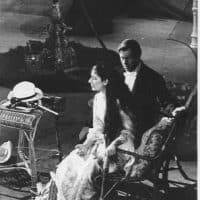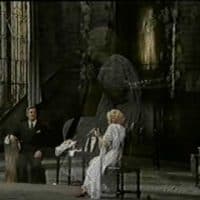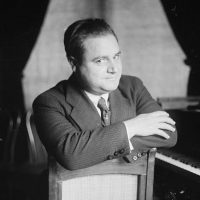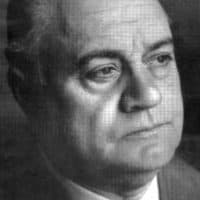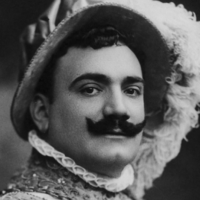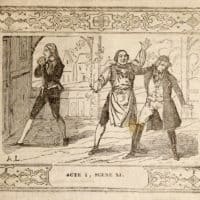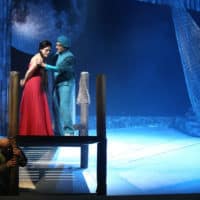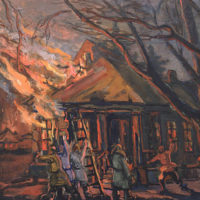[fancy_header3]Grandi Tenori week[/fancy_header3]
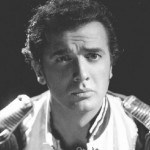
Dario Corelli (‘Franco’ was an adaptation for the stage) was born in Ancona, Italy, in 1921. The exact date of birth is uncertain, but sources commonly hold it to have been 8 April, even though the date 23 August 1923 has been suggested. For a short period he studied at the Music Conservatory of Pesaro, Rossini’s birthplace, attending classes with soprano Rita Pavoni, but gave up his studies as he discouragingly seemed to be losing his high notes, believing the baritone repertory could be more suited to him. A friend, who also studied at the conservatory, eventually led his attention towards maestro Arturo Melocchi, who had been Del Monaco’s vocal tutor, and showed him the technique that had made Del Monaco famous, which consisted in lowering the larynx. Corelli met with Melocchi sporadically, and relied mostly on his proper intuition.
With the help of Maestro Ottavio Ziino he made his debut at the Sperimentale festival of Spoleto in August 1951. He sang Don José in Carmen, and rave reviews immediately followed, praising Corelli’s voice and range. Shortly after, in January 1952, he was engaged for three performances of Zandonai’s Giulietta e Romeo at Rome’s Teatro del Opera, and he returned four months later for a single performance of Adriana Lecouvreur with Maria Caniglia, Maria Benedetti and Tito Gobbi. Corelli’s compelling performance convinced the direction of the theater into permanently engaging Corelli, and he was retained for performances of Carmen at the theater’s summer season at Caracalla. He also performed in Carmen at Trieste’s Castello di San Giusto, in San Remo and in Torino, all with Giulietta Simionato.
Corelli had by now rapidly gained acknowledgment and sang Boris Godunov with Boris Christoff at the Teater del Opera in December 1952, now a major force to be reckoned with at the opera. In March 1953 he was chosen for the world premiere of Guerrini’s Enea with Antonietta Stella and Christoff, and in April he entered the stage with Maria Callas in Bellini’s Norma. The cast also included Fedora Barbieri, Giulio Neri and Gabriele Santini and reviews were overwhelming. He had succeeded in gaining international reputation within no less than two years of his professional debut. In May 1953 he was chosen for the first Italian production of Prokofiev’s War and Peace (Pace e Guerra) at the Maggio Musicale Fiorentino, and during the summer of 1953 he starred in Pagliacci as Canio in Rome, as Don Jose in Carmen in Bolzano, Enna and Ravenna, as well as a single performance of Pagliacci in Spoleto. In November he reappeared with Maria Callas as Pollione in Norma, followed by further performances of Norma throughout 1954 in Modena and Parma.
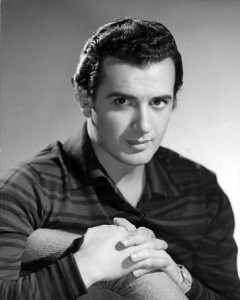 In March 1954 he debuted in Don Carlo to excellent reviews in Rome and was selected for the premiere of Spontini’s Agnese Di Hohenstaufen in May in Firenze. In September he recorded Pagliacci for RAI in Milano before making his debut at La Scala 7 December 1954, in Spontini’s La Vestale opposite Maria Callas. The performance received rave reviews and Corelli came to be dubbed the “Sputnik Tenor” for his swift rise to popularity throughout Italy. In 1955 he participated in a black and white film of Tosca, edited from RAI in Milano and broadcasted on television. A year later he starred in a full colour version, from Roma, starring Franca Duval as Tosca, Corelli as Cavaradossi and Afro Poli as Scarpia, with the voices of Maria Caniglia (Tosca), Corelli (Cavaradossi) and Gian Giacomo Guelfi (Scarpia). There was further one television broadcast from Milano, this time of Turandot, produced by RAI and televised 23 December 1958. The cast included Corelli as Calaf, Lucilla Udovich as Turandot and Renata Mattioli as Liù.
In March 1954 he debuted in Don Carlo to excellent reviews in Rome and was selected for the premiere of Spontini’s Agnese Di Hohenstaufen in May in Firenze. In September he recorded Pagliacci for RAI in Milano before making his debut at La Scala 7 December 1954, in Spontini’s La Vestale opposite Maria Callas. The performance received rave reviews and Corelli came to be dubbed the “Sputnik Tenor” for his swift rise to popularity throughout Italy. In 1955 he participated in a black and white film of Tosca, edited from RAI in Milano and broadcasted on television. A year later he starred in a full colour version, from Roma, starring Franca Duval as Tosca, Corelli as Cavaradossi and Afro Poli as Scarpia, with the voices of Maria Caniglia (Tosca), Corelli (Cavaradossi) and Gian Giacomo Guelfi (Scarpia). There was further one television broadcast from Milano, this time of Turandot, produced by RAI and televised 23 December 1958. The cast included Corelli as Calaf, Lucilla Udovich as Turandot and Renata Mattioli as Liù.
Corelli was triumphant in Italy and became the leading spinto tenor at La Scala and Roma during the 1950’s, where he appeared most frequently and to utter success in roles like Don José (Carmen), Mario Cavaradossi (Tosca), Calaf (Turandot), Manrico (Il Trovatore), along with the surprising and much talked about performances of Händel’s Giulio Cesare in Egitto in Roma December 1955 and January 1956 and later at La Scala in December 1956; Händel’s Hercules at La Scala in December 1958 with Schwarzkopf, Barbieri, Bastianini and Hines; Bellini’s Il Pirata opposite Maria Callas at La Scala, May 1958; Adriana Lecouvreur in November 1959 with Olivero, Bastianini and Simionato, in Napoli and the triumphant Poliuto at La Scala in 1959 with Maria Callas.
His UK (London) debut came in 1957 with Tosca at Covent Garden, starring soprano Zinka Milanov as Tosca. It was Corelli’s most important appearance outside Italy to date and prepared the ground for Corelli’s forthcoming success in America. The Tosca at Covent Garden followed the described motion picture of 1956, which partly introduced the tenor to the American public. However, it was not until January 1961 that he actually performed in the US, when making a joint debut at the Met with soprano Leontyne Price. The occasion was Il Trovatore for the commemoration of the 60th anniversary of the death of Giuseppe Verdi. The reception was overwhelming with standing ovations carried on for almost an hour after the performance, and Corelli fully conquered the Met public with celebrated performances that very season in Andrea Chenier and Turandot, the latter revived after nearly 30 years of absence at the house.
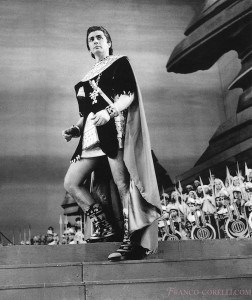
After splendid performances in La Gioconda in New York 1962, he left for Salzburg and the Summer Festival for a staging of Il Trovatore. The invitation had come from Herbert von Karajan. Salzburg was left breathless. He further stunned opera lovers with a triumphant Gli Ugonotti (Meyerbeer) at La Scala, perhaps his most difficult role to date. It was a role thought entirely unsuited to him, given the dark hue of his voice and the horridly high tessitura of the part. Andrea Chenier opened the Met season in October and the Corelli decade at the Met had begun.
Corelli now escalated to stardom by becoming the leading spinto tenor at the Met, so popular was the Italian that operas were staged specifically to display his talents. During his undisputed reign with the house starred in and excelled in roles such as Manrico (Trovatore, role debut and Met debut 1961), Calaf (Turandot, role debut 1961), Don Carlo (Don Carlo, 1961), Radamès (Aida, 1961), Cavaradossi (Tosca , 1962), Enzo (La Gioconda, 1962), Andrea Chenier (Andrea Chenier, 1962), Ernani (Ernani, 1962), Maurizio (Adriana Lecouvreur, 1963), Turiddu (Cavalleria Rusticana, Met Spring Tour to Boston), Rodolfo (La Bohème, 1964), Don Alvaro (La Forza del Destino, 1975), Dick Johnson (La Fanciulla del West, 1965) Rómeo (Rómeo et Juliette, 1967), Don José (Carmen, concert-form 1968), Edgardo (Lucia di Lammermoor, 1971) Werther (Werther 1971) and Macduff (Macbeth, 1973).
When approaching his 50 years of age, a crucial and feared stage in the career of any tenor, Corelli began to cancel performances more and more frequently, lead by his growing stage freight and nerves, and he become known in later years for his last minute cancellations. In fact, Plácido Domingo advanced his Met debut (if only by four days) in September 1968 when Corelli cancelled his part in Adriana Lecouvreur less than an hour before curtain time. The excuse was hoarsness.
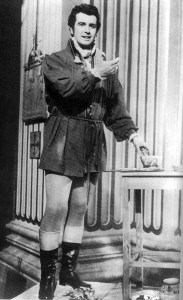 Fans who often gathered in the hallways back stage where Corelli had his dressing room reported of a pale and haunted tenor just before going on stage, walking up and down singing passages from that night’s opera, sick with worry that he’d might not be able to sing the role. He was the undisputed king of opera of the 60’s and he was in doubt about his own voice. Perhaps was he also haunted by his wife, Loretta: there are numerous stories from fans backstage that tell of how she used to barricade herself in his dressing room at intermission and yell at him, telling him what he had done wrong, and even yell at him from the wings when he was back on stage.
Fans who often gathered in the hallways back stage where Corelli had his dressing room reported of a pale and haunted tenor just before going on stage, walking up and down singing passages from that night’s opera, sick with worry that he’d might not be able to sing the role. He was the undisputed king of opera of the 60’s and he was in doubt about his own voice. Perhaps was he also haunted by his wife, Loretta: there are numerous stories from fans backstage that tell of how she used to barricade herself in his dressing room at intermission and yell at him, telling him what he had done wrong, and even yell at him from the wings when he was back on stage.
Eventually he experienced the feared defeat on stage, it came when doing Lucia di Lammermoor at the Met in January 1971. There was one performance on 11 January with Roberta Peters, and the audience witnessed how Corelli struggled with the tessitura, mostly scooping in the passaggio singing and seemed totally uncomfortable with the role. It was reported to be his worst performance to date. The next performance, on 21 January, after having done Andrea Chenier (14 January) and Ernani (16 January) at the Met in between, he sounded no better than the previous night and abandoned the performance after 1st act and was replaced by tenor John Alexander.
No doubt Corelli’s voice had become rougher around the edges, and the Lucia flop came after an intense performance schedule starting with Carmen in Verona during July and August, 8 performances of Don Carlo in Wien in October and November, recording sessions of Carmen in Berlin, a recital 13 December in München, Carmen in Beograd 16 December, La Boheme in Beograd 19 December and finally Ernani at the Met 8 January. Yet he was utterly triumphant on 27 February for his debut as Werther at the Met, opposite Christa Ludwig, and all following performances were sold out, even though critics might have been ambigious. Manager Bing, however, who partly encouraged Corelli to take on the French romantic repertory, contrary to the tastes of ardent Corelli fans, was thrilled, just as he had been with Romeo et Juliette autumn 1967.
The Werther sucess continued in 1972, and the last role he added to his Met repertory was a surprising Macduff in Macbeth, which he performed for the first time on May 15 1973. Still, there were expectations for yet another role: Under the Farwell Gala for retiring manager Rudolf Bing at the Met April 22, Corelli and Teresa Zylis-Gara sang the duet “Già nella notte densa” from Otello, leading to much speculations about a foreshadowed appearance in Otello. Corelli himself was contemplating the idea, but plans were postponed and the opportunity never showed.
1973 he toured the US, appeared in Carmen and Turandot in Lisboa, held several recitals in the Far East before returning to New York and performances in La Boheme at the Met. Opera perfomances were now getting scant, and for the most part he sang in Turandot at the Met during 1974. 1975 he sang in Rome et Juliette and La Boheme at the Met, then Carmen and Turandot at the Arena di Verona in July and August and the he disappeared, after cancelling Norma during rehearsals at the Met in November. For a whole year Corelli did not perform and when he reappeared it was to be his very last performance in a complete opera: He sang the role of Rodolfo at the Torre de Lago under Nino Sanzogno, and Adriana Maliponte was his Mimi.
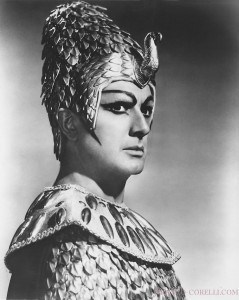 Corelli now officially retired from the stage, sensing that he was no longer able to to give the audience what they had become so accustomed to expect from him. Besides, he was losing interest in the stage and felt at last also relief: “I was a bundle of nerves,” he later explained, making it clear that he did not miss the pressure of going on stage. Later his voice did perhaps regain its bloom, but Corelli had now grown comfortable off-stage and did not return, except for 5 last recitals in 1980-81, one in June 1980 in New Jersey, April 1981 in Newark, San Diego in May, Holmdel (New Jersey) in July and finally Stockholm in November, participating in a Gala Concert in honour of Swedish soprano Birgit Nilsson. Instead he turned to vocal teaching, together with his wife Loretta, and held occasional Master Classes.
Corelli now officially retired from the stage, sensing that he was no longer able to to give the audience what they had become so accustomed to expect from him. Besides, he was losing interest in the stage and felt at last also relief: “I was a bundle of nerves,” he later explained, making it clear that he did not miss the pressure of going on stage. Later his voice did perhaps regain its bloom, but Corelli had now grown comfortable off-stage and did not return, except for 5 last recitals in 1980-81, one in June 1980 in New Jersey, April 1981 in Newark, San Diego in May, Holmdel (New Jersey) in July and finally Stockholm in November, participating in a Gala Concert in honour of Swedish soprano Birgit Nilsson. Instead he turned to vocal teaching, together with his wife Loretta, and held occasional Master Classes.
Corelli’s career was perhaps a strange one, starting with heavy repertory and continuing with lighter, contrary to most tenor careers. His incursions into the the lyric and romantic French repertory late ’60s and early ’70s, manifested through his recording for Decca of Gounoud’s Faust in London during the summer of 1964, as well as his successful appearances at the Met in Gounod’s “Romeo et Juliette (1967) and Massenet’s “Werther” (1971), marked a path in a different direction that perhaps would have been logical for a voice of Corelli’s calibre: His career would logically have gone along the line of heroic high roles, with Arnoldo of Rossini’s Guglielmo Tell as the extreme, or dramatic low (baritonal) roles, particularly Otello. Instead he chose to scale down his huge voice and sing softly, much to Bing’s delight, who paid duly to see Corelli sing in French. Corelli himself, however, was never truly convinced of his choice, these were difficult parts for him, and in the end prevented him from singing in particular two parts the opera world sadly missed out: Manon Lescaut and Otello.
His most cherished roles were Andrea Chenier, to many unsurpassed in this century, and probably his Calaf or Cavaradossi, which heroic spinto qualities matched those of Corelli perfectly. He was also an admired Manrico, first at La Scala, then the Met and the Wien Staatsoper. Himself, he often held Don José in Carmen to be one of his best roles, oddly enough he never performed this role at the Met.
Franco Corelli passed away in Milano, where he resided, on 29 October 2003 at 82. With his death one of the last great tenors of the 20th century is gone.
